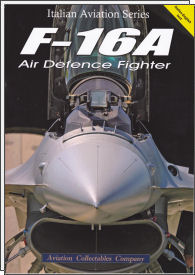| F-16A Air Defence Fighter |
CAPITOLI Introduzione Le origini e lo sviluppo Il programma Peace Caesar In servizio con l'Aeronautica Militare L'impiego bellico Note modellistiche Dettagli modellistici Dati tecnici - Armamenti - Matricole Ringraziamenti/ Bibliografia INTRODUZIONE A differenza di altre nazioni europee aderenti alla NATO, che utilizzano l'F-16 fin dagli anni Ottanta, l'Aeronautica Militare italiana è stata una delle ultime aviazioni del vecchio continente ad introdurre in servizio il famoso monoposto della General Dynamics/ Lockheed Martin e solo come "gap filler" tra la radiazione degli ultimi F-104S/ASA-M "Starfighter" e l'arrivo dei primi F-2000 "Typhoon". In Italia, infatti, l'F-104 succedette a se stesso e gli F-104G furono sostituiti dalle versioni F-104S a partire dal 1969, F-104S/ASA nella seconda metà degli anni Ottanta e F-104S/ASA-M a metà degli anni Novanta. Questa lunga catena di versioni del noto "spillone", in realtà tutti aggiornamenti di sistemi su una macchina eccezionale in termini di prestazioni, ma obsoleta come concezione, avrebbe dovuto accompagnare i reparti da caccia della Forza Armata alla transizione sul "Typhoon", che però accumulava ritardi e sarebbe entrato in servizio solo nel febbraio 2004. Lo Stato Maggiore Aeronautica (SMA) decise, pertanto, di trovare una soluzione temporanea orientandosi su una linea caccia formata da 60 F-104S/ASA-M affiancati da 24 esemplari di un aereo scelto tra F-15, F-16 o Panavia "Tornado" F.3, anche detto Air Defense Version (ADV - versione da difesa aerea), da acquisire per un limitato periodo di tempo. La scelta, dettata da motivazioni economiche, politiche e logistiche, cadde sul velivolo britannico acquistato in leasing al costo di 700 miliardi di Lire. In base agli accordi la Royal Air Force (RAF) avrebbe ceduto per un periodo di dieci anni 20 "Tornado" F.3 e 4 F.3T a doppio comando. Nonostante le prestazioni e le caratteristiche tecniche dell'aereo inglese fossero notevolmente superiori a quelle degli "Starfighter" e l'impiego del velivolo consentisse un vero e proprio salto di qualità alla linea caccia dell'Aeronautica Militare, i costi di gestione operativi e logistici erano decisamente elevati e, alla fine del 2000, gli aeroplani avrebbero dovuto essere sottoposti ad un costoso aggiornamento denominato "Tornado" F.3 Sustainment Programme (FSP). Oltre a questi problemi, altri ritardi accumulati dal "Typhoon" ne avrebbero posticipato l'ingresso in servizio e quindi si rese necessaria un'ulteriore soluzione, anche questa temporanea, al fine ai mantenere un livello qualitativo accettabile nel campo della difesa aerea. Per ottimizzare i fondi disponibili, lo SMA decise quindi di concludere anticipatamente il contratto di leasing con la RAF e di sottoscriverne un altro, adottando un differente velivolo: furono valutate diverse opzioni, F-15, F-16, Mirage 2000 e, il 1° febbraio 2001, il Ministro della Difesa annunciò che la scelta era caduta sull'F-16 nella versione da difesa aerea ADF. |
CHAPTERS Introduction Origin and development Peace Caesar program In service with Italian Air Force Tornado at war Modeller's notes Modeller's details Technical data - Weaponry - Serials Acknowledgements and Bibliography INTRODUCTION Italy was late, respect to the other NATO's European countries, in adopting the F-16. Having entered in service since the eighties in the old continent, ItAF specifically used the famous General Dynamics / Lockheed Martin F-16 as gap filler, from the writing-off of the fast F- 104 "Starfighters” to the introduction of the new F-2000 "Typhoon". In Italy, the successor of the F-104 was itself same, in the form of the F-104S in 1969, and then followed by two upgrades, F-104S/ASA during the mid-eighties and the ASA-M in the mid-nineties. Albeit an exceptional machine performance-wise, the ageing F-104 was the result of obsolete conceptions, and wasn't anymore able to protect the Italian airspace; anyway the initial planning was to use the F-104 until the F-2000 was ready. But "Typhoon" development was delayng; in fact entered service only in February 2004 with 4th Wing 9th Squadron based in Grosseto. ItAF Chief of Staff then decided to find a temporary solution to allow a better protection of Italian skies. The output of this decision was to have, for a short period of time, a mixed line composed by sixty F-104S/ASA-M and twenty four more aircrafts, to be chosen between F-15, F-16 or Panavia "Tornado" F.3, in the Air Defense Version (ADV). The choice, motivated by logistical, economical and political reasons, felt on the Panavia interceptor, leased from used RAF machine for a total of 700 billion Lira (350 €/ mil). This agreement was signed for the lease of twenty single pilot "Tornado" F.3 and four F.3T double controls aircrafts. Notwithstanding the superior performances and technical improvements were far superiors to the "Starftghters", allowing to Italian Air Force a huge leap for its fighter line, logistic and maintenance costs were definitely high; furthermore all the line, during year 2000, should follow a deep and expensive update, called "Tornado" F.3 Sustainment Programme (FSP). Besides that, economy and more delays accrued by the "Typhoon", postponing more its inception, another change in management of the fighter line was necessary to maintain a credible quality in air defense. In order to optimize the available funds, Italian Air Staff decided to end the contract with the Royal Air Force, signing a new one for a different aircraft. The bid was held between F-15, F-16 and Mirage 2000: on February 1st 2001 the Defense Minister announced that the "Fighting Falcon" was chosen in its ADF form. |

|
||
| ©1999-2025 Tutti i diritti riservati Cell +39 3490876581 Spedizioni corriere espresso in Italia P.IVA 01172300053 - Cod.Fisc. BSSVCN50C23B425R - REA AT-93224 |